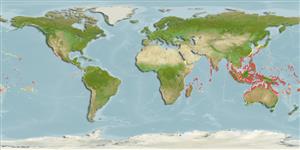Common names from other countries
Teleostei (teleosts) >
Eupercaria/misc (Various families in series Eupercaria) >
Scaridae (Parrotfishes) > Scarinae
Etymology: Scarus: Greek, skaros = a fish described by anciente writers as a parrot fish; 1601 (Ref. 45335).
More on author: Bleeker.
Environment: milieu / climate zone / depth range / distribution range
Ecology
Marine; reef-associated; depth range 2 - 25 m (Ref. 37816). Tropical
Indo-Pacific: widespread in the Indian Ocean (Ref. 9793), ranging from East Africa south to Natal, South Africa (Ref. 5490) and east to Madagascar, Seychelles, Mauritius, Chagos Archipelago, and Maldives through the eastern Indian Ocean to French Polynesia and Pitcairn. Replaced by Scarus forsteni in most of the Pacific, with overlapping distributions in the Philippines, eastern Indonesia and Palau (Ref. 37816). Recently reported from Tonga (Ref. 53797).
Size / Weight / Age
Maturity: Lm ? range ? - ? cm
Max length : 52.7 cm TL male/unsexed; (Ref. 125599); common length : 17.5 cm SL male/unsexed; (Ref. 9793); max. published weight: 2.9 kg (Ref. 125599)
Dorsal
spines
(total): 9;
Dorsal
soft rays
(total): 10;
Anal
spines: 3;
Anal
soft rays: 9. Males differ slightly in head pattern and differences most obvious in females with yellow or red anal fins (Ref. 48636). Terminal phase similar to S. forsteni, differing primarily by having a yellow inner pectoral axil (Ref. 37816).
Inhabits lagoon and seaward reefs, in areas with dense coral growth (Ref. 9710) up to at least 30 m. Usually solitary, sometimes in groups (Ref. 9710). Feeds on benthic algae (Ref. 3488).
Life cycle and mating behavior
Maturity | Reproduction | Spawning | Eggs | Fecundity | Larvae
Oviparous, distinct pairing during breeding (Ref. 205).
Randall, J.E. and J.H. Choat, 1980. Two new parrotfishes of the genus Scarus from the Central and South Pacific, with further examples of sexual dichromatism. Zool. J. Linn. Soc. 70:383-419. (Ref. 2689)
IUCN Red List Status (Ref. 130435)
CITES (Ref. 128078)
Not Evaluated
Threat to humans
Harmless
Human uses
Fisheries: commercial; aquarium: commercial
More information
ReferencesAquacultureAquaculture profileStrainsGeneticsElectrophoresesHeritabilityDiseasesProcessingMass conversion
Tools
Special reports
Download XML
Internet sources
Estimates based on models
Preferred temperature (Ref.
115969): 24.9 - 29.3, mean 28.4 (based on 3096 cells).
Phylogenetic diversity index (Ref.
82804): PD
50 = 0.5000 [Uniqueness, from 0.5 = low to 2.0 = high].
Bayesian length-weight: a=0.01778 (0.01082 - 0.02921), b=3.06 (2.93 - 3.19), in cm Total Length, based on LWR estimates for this species & Genus-body shape (Ref.
93245).
Trophic level (Ref.
69278): 2.0 ±0.0 se; based on diet studies.
Resilience (Ref.
120179): Medium, minimum population doubling time 1.4 - 4.4 years (Preliminary K or Fecundity.).
Fishing Vulnerability (Ref.
59153): Moderate vulnerability (41 of 100).
